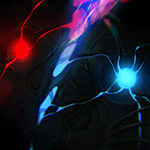Raccoon Dog as a Species
3 posters
Page 1 of 1
 Raccoon Dog as a Species
Raccoon Dog as a Species
Interesting facts :
The generic name Nyctereutes comes from the Greek nyctos meaning 'night' and ereuna meaning 'seeking'. The specific epithet procynoides derives from the Greek prokyron meaning 'before dog' and eidos meaning 'form'. The most widely used vernacular name is the Japanese 'Tanuki'. The tanuki is the subject of many Japanese folk tales and children's stories.
[You must be registered and logged in to see this link.] IN PROGRESS.
The taxonomic position of Nyctereutes is not clear. Some placed the genus with the procyonids, others recognized it as a distinctive canid genus. Its phylogenetic relationships with the Canidae are not well-resolved. Its shows no close affinities with other canid genera. Karyotypically, raccoon dogs are unusual among canids in the possession of supernumary chromosomes and of other chromosomes that are homologous to those of the members of the Felidae.
Generals characteritics
The raccoon dog is about the size of a small fox; the body is relatively elongated, and the head is small with a short and sharply pointed muzzle and short, rounded ears. The furry tail is <33% the length of the body. The face resembles that of a racoon; a black mask covers the eyes and extends beneath the muzzle. A broad white band that includes the tip of the muzzle, extends across the face from above the eyes to the ears. Thick fur occurs about the neck ; the head is well-furred on the sides making it appear broad. Small ears, edged with black with white inside, barely protrude from the winter coat. The chest, throat, and feet are blackish-brown and a dark stripe connects the black of the chest and feet with the shoulder to form a cross-shaped pattern on the anterior part of the back. Fur on the tail and sides is tinged with cinnamon ; the belly and inner parts of the legs are yellow-brown in color. Soles of the feet are naked. The tail had a black dorsal stripe and a black tip. In cold climates, a heavy winter coat of thick and soft underfur and long guard hairs develops, giving the animal a short-legged appearence. In summer and in warm climates, the coat is thin and the animal appears more gracile. The color of the winter pelage is brownish-gray with black markings, whereas the sommer pelage is strawish-orange and blackish-brown.
Measures :
Average mass (in kg) in Japan for males is 4.02 and 4.87 for females. In China, males is 3.47 and 3.80 females. The average length is 670 mm. Length of tail is 160 mm. Average height is 380 mm at the shoulder.
Distribution :
Raccoon dogs inhabit areas of forested streams or river valleys, and areas surrounding lakes, where thick underbrush, marches, or reedbeds provide dense cover. The original range included the Amur and Ussuri regions of eastern Siberia; northern China southward to the states of Shansi, Szechuan, and Yunnan in the west and Fukien in the east; North Vietnam, Korea, and Japan.
Between 1927 and 1957 they were introduced, both intentionally and accidentally as escapees from fur farms, to several regions of European and Asian USSR where they are now feral (Novikov, 1956).
As a result of their high reproductive capacity, adaptability and general lack of enemies, raccoon dogs spread rapidly throughout northern and western Europe and are now reported in Finland, Sweden, Norway, Poland, Romania, Czechoslovakia, Germany, France, Austria and Hungary.
Fossil Records:
Remains of N. donnezani, the ancestor of the racoon dog, were found in late Pliocene site in northern Italy, France, Hungary and Romania. A larger form, N. megamastoides, appeared in Spain, France and Hungary in the early Pleistocene and was perhards identical to a large mid-Pliocene animal, N. sinensis, found in China. A late Pleistocene fossil from Palestine, N. vinetorum, also may have been related to N. megamastoiodes. The European form became extinct in the Pleistocene, whereas N. sinensis survived and underwent a reduction in body sixe to the modern raccoon dog. The earliest records of fossils of the raccoon dog from Japan is that of a relatively large form, N. viverrinus nipponicus, from mid-upper Pleistonece deposits in Totigi Prefecture. This fossil had been described as the connecting link between N. sinensis of China and other fossil races, N. v. genitor and N. v. okuensis, from Neolithic sites in Japan. Fossils of the latter two races were animals slightly larger than the living N. p. viverrinus.
Fur and bones :
Thermal insulation of fur is the primary factor affecting heat economy; hair-coat insulation properties are better in Alopex lagopus (Artic Fox) than in N. procyonoides. At 10°C, the raccoon dog increases its metabolism whereas that of A. lagopus remains unchanged. It is suggested that this may be one factor that places a northern limit on southern species. Juvenile and adult raccoon dogs under commercial fur-farm conditions undergo a summer molt between July and October. The molt begins posteriorly and advances toward the head. It is followed by the growth of a dense winter pelage in the months of September, October, and November. Hair growth ceases in late November or December. In April, the spring molt begins and the dense underfur is shed. Growth of the thinner summer pelage begins at the head and advances toward the tail; the winter underfur is replaced by mid-June. Guard hair molts vary, but by July most winter guard hairs are lost.
Nyctereutes has a relatively distinct post-cranial skeleton characterized by heavy cervical vertebrae and stout appendicular bones in contrast to the lighter skeletons of cursorial canids, such as Canis latrans and C. lupus. Pelvis and femur proportions, which are correlated with running ability, favor slow leg movements in the short-legged raccoon dog. It is probably not a swift canid. The baculum is similar to that of Canis, but straighter and with a narrower base, as in Urocyon.
Reproduction :
Raccoon dogs live in pairs or in small groups, but it is not clear whether they are monogamous or polygamous. Females are monestrus and come into heat during the first warm days of January, February, or March ; the exact time varies with geographic location. Estrus in females from a fur-farm population ranged from 3-5 days. Profiles of the concentration of sex steroids in the plasma generally are similar to those of dog (Canis familiaris) and Artic Fox (A. lagopus). Estradiol-17B levels peak (55pg/ml) during pro-estrus or at beginning of estrus. After coitus, the concentration falls and remains low during pregnancy. Progesterone concentrations are low during proestrucs and increase rapidly to a maximum (23.4 ng/ml) during the first hald of pregnancy; thereadter, the level falls and remains low, <1 ng/ml. Gestation is 59 to 64 days.
The average litter size is 5-7 but litters with as many 19 pups have been observed.
Lactation lasts from 1.5 to 2 months. The neonates are born blind, and are covered with soft, black fur. The eyes open in 9-10 days and teeth erupt in 14-16 days. Mass and body measurements increase almost linearly during the first 50 to 60 days of life and by 80 to 85 days have reached values typical of subadults. Weaning occuers at 30 to 40 days, by which time the coat consists of guard hair and underfur, and the characterisitic dark facial mask is developed. The color pattern of the adult, with the cross-shaped black design anterioly on the back, usually is apparent within 50 days.
A male brings food to the pregnant female. Males assists in postnatal care of the offspring. The young participate in hunting and are self supporting by 4-5 months of age, at which time they are almost adult-size, but lighter in color. the offspring often remain with the parents throughout the summer and take up independant existance in the autumn. Sexual maturity begins at about 9-11 months.
Ecology
Raccoon dogs are omnivorous and opportunistic in feeding habits. In hunting, the animal follows a wandering, stop-and-go path, its nose to the ground as it searches for food. Although the raccoon dogs does not move fast, it is highly mobile and roams restlessly in search of food. Its basic foraging behavior is that of a collector or gatherer of items from the forest floor. Plant parts eaten includes roots, stems, leaves, bulbs, fruits, nuts, berries and seeds. The parts eaten correspond well to the growing or fruiting season of the plant species. Prey is limited to small animals (rodents, reptiles, amphibians, birds and theirs eggs, mollusks and arthropods). Raccoon dogs are skilled fisherman and in areas near rivers, lakes, and marshes, fish and amphibians compose a major part of the diet. On the seashore, they eat sea urchins, crabs, dead fish, and carcasses of seabirds and other marines animals. When commensal with man, raccoon dogs exploit refuse, grain crops, domestic fowl, games birds and their eggs, and the offal of domestic animals.
Large differences in the diet occur in different habitats and seasons. In Japan, raccoon dogs on a small island showed little evidence of predation on a dense population of rodents, but fed on fish and crams and relied heavily on plant and insect matter as the main food throughout the year. However, in Finland during the snowless period of the year, rodents formed the major portion of the diet, with plant matter, amphibians, invertebrates and birds comprising a small part of the diet.
The typical habitat of raccoon dogs provides thick protective cover, is rife with small vertebrate and invertebrate prey species, and is potentially rich with nuts, fruits, and berries for part of the year. Such habitats require moisture and throughout its original and introduced range the raccoon dog occurs near lakes, rivers, streams, and marshes. In elevation, habitats have ranged from near sea level to >3.000 m in Yunnan. In Siberia, raccoon dogs occur in broadleafed forests, shrub thickets and in plains and marshy areas near rivers, brooks and small lakes. They avoir conifer taiga, probably because of its characteristic lack of undergrowth and potential food sources. In Japan, they occupy mized broadleaf-coniferous forests near lakes and rivers or the seashore.
Predators
Include the wolf, lynx, wolverine, marten, golden eagle, sea eagle, eagle owl and domestic dogs. Man is the major predator of the raccoon dog. The raccoon dog is the principal fur animal of the northwestern and central regions of the USSR and it is widely hunted there. In most parts of Europe, the coat is too thick to provide satisfactory furs, and raccoon dogs are killed because they are considered a danger to small-game animals and wildfowl and are transmitters of diseases, especially anthrozoonoses. Raccoon dogs are killed by hunters, chiefly with guns or dogs.
Raccoon dogs are susceptible to mange, rabies, piroplasmosis and helminth infestations.
The natural lifespan of wild raccoon dogs is not known. Of 320 trapped raccoon dogs analyzed, the oldest age class was 5.5 years for males, 7.5 years for females. Younger animals comprised 68.4% of the total population, a finding that may have indicated heavy hunting pressure. Longevity of captive raccoon dogs has exceeded 14 years.
Mating :
- Spoiler:
- Pairs form during the breeding season and remain together after birth of the young, but the duration of the pair bond is unknown.
Females are courted by one or sometimes three or four males. Fights between suitors are rare. In captivity, the frequency of male-female interactions and scent marking increases during proestrus. Copulatory behavior in raccoon dogs diffres slightly from that of most canids. During sexual arousal in males, the tail forms an inverted U-shape, characteristic also found with the Bat-Eared Fox. Male and female do not achieve the typical back-to-back canid tie.
Behavior :
Observations of zoo animals indicate that sleeping and resting in contact with one another occurs regularly. They usually hibernate in pairs. They also frequently engage in social grooming and share this characteristic with only one other canid, the Bat-Eared Fox.
Raccoons dogs don't back, but emit a high-pitched whine, whimper or mewing, usually associated with friendly or submissive bihavior. Tail-wagging of submissives, typical of other canid species, does not occur in raccoon dogs. When threatened or threatening, the animal responds with a throaty growl.
Wild and captive raccoon dogs use 'latrines'; this may serve as a basis for information exchange by olfactory clues between individuals and their families. Olfactory sense is keener than sight in raccoon dogs and is of primary importance in food acquisition.
Raccoons dogs are opportunistic and use burrows made by other animals or dig their own. They have been found living among stones, in cracks in rocks, hollow tree trunks, and shrubs. In marshes, they live in heaps of hay or grass. In areas inhabited by people, they live under roofs or in lofts or temples.
This is the only canid that hibernates. Hibernation generally begins in November and extends through March or early April. The animals do not sleep deeply and may emerge from the den on warm winter days to forage for good. The depth of winter sleep depends on the amount of stored fat; animals that have insufficient fat must be active all winter. In late autumn in cold regions, mass may increase by almost 50%. The hibernation den may be insulated with dry grass or moss. In the southern part of the range, they do not hibernate.
Thanks for reading, that took foreveeeeeeer. XD
Last edited by Akimori on Fri Aug 12, 2016 2:34 pm; edited 1 time in total

Akimori- Kin/Therio type : Tanuki
Age : 32
Job/hobbies : Writing a thesis / Read
Join date : 2016-06-27
Your Kin self Information Sheet
Name of your kin self : :
What is your kin type ? :
Describe it Physically : :
 Re: Raccoon Dog as a Species
Re: Raccoon Dog as a Species
Interesting info! (I thought they could bark like other canines, apparently I was wrong :P) I love the little captions you put underneath each picture.

Taylarn- Kin/Therio type : Feline and Wolf
Job/hobbies : Writing, Drawing
Join date : 2016-06-28
 Re: Raccoon Dog as a Species
Re: Raccoon Dog as a Species
- Thank you Taytay!
It took forever to transcribe, but I learned alot more about myself and tanuki!
I tried to make it as interesting as possible, since it's a long wall of text. :P

Akimori- Kin/Therio type : Tanuki
Age : 32
Job/hobbies : Writing a thesis / Read
Join date : 2016-06-27
Your Kin self Information Sheet
Name of your kin self : :
What is your kin type ? :
Describe it Physically : :
 Re: Raccoon Dog as a Species
Re: Raccoon Dog as a Species
YAYYY :D thanks ! Ill go eat and RP just after, promise xx

Silver Black- Owner

- Kin/Therio type : Naerubie ( celestial wolf guardian )
Age : 33
Job/hobbies : Comission Artist, Gamer, Singer, working at my own terms.
Join date : 2016-06-24
Your Kin self Information Sheet
Name of your kin self : : Silver Black
What is your kin type ? : Naerubie ( Interdimensional Angel Wolf being )
Describe it Physically : : winged wolf with avian features -

 Similar topics
Similar topics» Mil's species: Taru
» What It Means to Be Trans Species
» Species Evolution : The coywolf
» Classification of werewolves species
» What It Means to Be Trans Species
» Species Evolution : The coywolf
» Classification of werewolves species
Page 1 of 1
Permissions in this forum:
You cannot reply to topics in this forum






